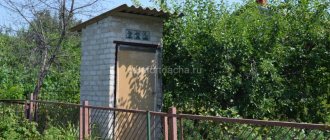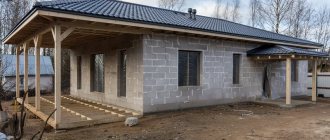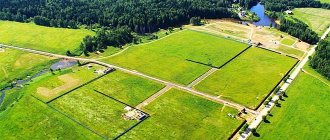Are neighbors prohibited from raising the property?
There is no prohibition on raising the level of the site in the current legislation. However, if water floods your area, you have the right to go to court. According to Art. 304 of the Civil Code of the Russian Federation, the owner may demand the elimination of any violations of his rights, even if these violations were not associated with deprivation of possession. You will have to conduct a construction and technical examination. The court may oblige the neighbor, in particular, to build a drainage ditch around his property.
In accordance with paragraph 45 of the resolution of the Plenum of the Supreme Court of the Russian Federation No. 10 and the Supreme Arbitration Court of the Russian Federation No. 22 dated April 29, 2010 “On some issues arising in judicial practice when resolving disputes related to the protection of property rights and other property rights” (hereinafter - resolution) by virtue of Articles 304, 305 of the Civil Code of the Russian Federation, a claim to eliminate violations of law not related to deprivation of possession is subject to satisfaction if the plaintiff proves that he is the owner or a person in possession of the property on the basis provided by law or agreement, and that the defendant's actions not related to deprivation of possession violate his property rights or legal possession. Such a claim must also be satisfied in the case where the plaintiff proves that there is a real threat of violation of his property rights or legal possession by the defendant.
What to do if you want to install a high fence
There are such difficult relationships with neighbors that the best way out is not to see them at all. Then the desire arises to put up a solid fence. Such complete isolation will allow you to fully enjoy the peace and quiet in your area.
To install a high-height fence you will have to perform the following manipulations:
- erect a fence according to the norm and in compliance with SNIP along the perimeter of your site;
- step back from it by 1 meter or more, if free space allows;
- build a fence of the required height.
This option will be more expensive, but in this case there can be no claims from neighbors or individual housing construction regarding the height of the fence between neighbors.
What is the procedure for raising the site?
There is such a document SP 53.13330.2011, this is an updated version of SNiP 30-02-97 (planning and development of sites).
This joint venture clearly states that “it is impossible to organize runoff (rain and melt water) onto a neighboring plot.” That is, if your neighbor did not violate all the rules of SNiPs (this and others) when raising the site, then he has the right to do so; there is no prohibition in the legislation on raising the site.
But if your area is flooded with water, this means that the SNiP (rules and regulations) were violated, otherwise you would not have been flooded. Then go to court (although you will have to pay for a construction and technical examination) there is almost a 100% guarantee that the court will be on your side, let it redo or completely eliminate the problem, for example, drainage at his expense, the court may oblige him to do this.
Currently, in accordance with paragraph 6.2.12 of the technical code of established practice 45-3.01-117-2008 (02250) “Urban planning. Areas of estate housing construction. Planning and development standards" work related to changing the natural topography of the area (filling of soil, cutting of soil) refers to the vertical planning of the territory and is the main element of improvement of the land plot being developed, which is carried out on the basis of design documentation, if the filling and cutting of soil will amount to more than 0.45 meters. Accordingly, adding 0.3-0.4 meters of soil is not a violation of current standards.
The fence and its role in demarcation
According to the current rules established by the Code of Standards and Regulations of 1997, there are certain requirements for the method of establishing the border between the plots of neighbors, their height and dimensions. Carrying out work to establish property boundaries has repeatedly revealed that violations continued for many years and neighbors were using someone else’s land illegally.
Fencing next to the driveway
Sometimes violators of established borders even managed to build permanent structures there. However, the law prohibits not only building on someone else’s land, but even installing barriers on the boundary is unacceptable.
According to existing rules, the construction of a fence must take place at a distance of at least half a meter from the established boundary, and on the side of each of the neighbors.
The developer has the right to erect a barrier structure on his territory - for this he has his own land, and at a certain distance from his neighbor he can even build a blank fence, but not on the border, but directly on his territory. Construction restrictions may be imposed if there is no passage to the neighboring house.
SNiP standards
Then a path 75 cm wide is allocated, most often, by mutual agreement, on both sides. And except as a pedestrian path, these 0.3 m on both sides can neither be used nor separated by a fence.
How to resist the neighbors who started this
Whatever the emotions, any actions in such cases must be consistent with the Law.
Namely, by acting within the limits of what is permitted, you can achieve the final result you require in the confrontation with your boorish neighbors. Many people associate the word “Law” with the word “bureaucracy,” but this is not so. Judicial practice in cases of flooding of land is quite rich; a clear algorithm for making decisions in favor of the injured party has already been developed. Before writing a statement of claim, you need to obtain two documents - an act on the fact of flooding of the site and a report on an independent assessment of the damage. The certificate of flooding of a land plot is authorized to be issued by: the village administration, the board of the dacha cooperative, the district commissioner and other government representatives in the locality. That is, this document is needed so that the court can see that flooding took place. This act is similar to a certificate of road accident, which is drawn up by the State Traffic Safety Inspectorate in the event of an accident, or a report of flooding of an apartment, which is issued by the DEZ in case of flooding of the premises.
An independent assessment of the damage caused to the land plot is needed to determine the cost of restoring the property to its original condition. As in the two above cases, an expert opinion on damage to a land plot is required to justify the cost of the claim to the court. A document expressing exactly the monetary amount of damage is prepared by an independent appraiser, who should be called to measure and photograph the extent of flooding of the summer cottage. The same damage assessment report is made when a neighbor has unauthorizedly moved a fence, dumped construction debris, broken a gate or broken trees.
How much does it cost to assess damage to a land plot?
The cost of the appraiser’s services depends on the specifics of the damage caused and is individual in nature. We cannot attach a table of prices to this article, as is the case with assessing damage after an apartment was flooded or as with assessing land as a single piece of suburban real estate. As a rule, the cost of damage assessment services on a site varies from 4,000 to 10,000 rubles. The exact cost of the services of an independent damage assessor depends on the specifics of the damage.
Damage can be caused not only to structures, but also specifically to the personal plot where these objects are located. Often there is a disrespectful attitude from neighbors in the area. Due to the irresponsible actions of neighbors or construction organizations, the land plot turns into a swamp or landfill, and a residential building, outbuildings, trees, shrubs, and planted plants are damaged.
Procedure for causing damage to land
The first thing to do is to document the fact of the damage caused. To do this, you need to contact the chairman of the horticultural non-profit partnership (SNT), the head of the settlement, the local authority or other government representative in the locality. The commission appointed by the manager must draw up an inspection report of the personal plot against flooding or other actions of neighbors. When drawing up the act, the victim must actively participate - give explanations and comments.
The second step will be to call a specialist to conduct an independent examination so that he can assess the damage to the site. An independent appraiser takes the necessary measurements, takes photographs of the extent of the damage caused and provides an expert opinion.
A report on the assessment of damage to the land plot and the actual cost of repair and construction work to restore the site will be required to apply to the court. With the help of the report, the victim will be able to justify in court the amount of monetary claims against the culprit. The cost of the appraiser’s services depends on the specific characteristics of the damage caused and is usually individual in nature.
To go to court, it is necessary to draw up a statement of claim with demands to recover from the culprit the amount of money indicated in the independent expert report. You should go to court with all three documents: an act of damage, an expert opinion and the statement of claim itself.
If it was not possible to reach an agreement with the owner of the adjacent plot peacefully, and your justified claim for compensation for damage was left unaddressed, submit a corresponding petition to the judicial authorities. During the consideration of the court case, an independent judicial examination will be appointed and, based on its results, the owner of the well will be obliged to compensate for the damage.
According to the requirements of civil legislation (Article 1064 of the Civil Code of the Russian Federation), damage caused to a citizen or his property is compensated in full by the guilty person.
At the same time, Article 151 of the Civil Code obliges a citizen who has caused moral harm, expressed in physical or moral suffering inflicted on the citizen, to compensate for the damage from these actions in the form of material compensation to the injured person.
The amount of monetary compensation for moral costs is influenced by the degree of guilt of the person who violated the rights of another citizen. At the same time, other aggravating circumstances of the case are also taken into account. When making a court decision to pay compensation, the consequences that occurred as a result of the moral suffering and the degree of damage are taken into account.
Within the framework of the provisions of Article 12 of the Civil Code of the Russian Federation, the injured person has the right to demand restoration of his rights in the following way: eliminate the circumstances that led to the violation of rights and establish the situation that existed before the unlawful actions.
Violation of boundaries and ways to resolve controversial issues
Before proceeding to resolve the conflict, it is important to understand whether the neighbor actually seized and violated the boundaries of the land plot, and how much the real boundary of the territory corresponds to the documentation. There are two options:
- Talk to your neighbor and find out what documents he used when moving the fence.
- Call a cadastral engineer to re-install the boundary signs. Important: the work must be carried out by a licensed organization.
According to the Rules for Establishing Territory Boundaries, approved by the Government of the Russian Federation on August 20, 2009, the cadastre is considered the main document for establishing the size of a territory.
The latter contains enough information to accurately mark the contour of the site on the ground using turning points and boundary signs. When starting to resolve the issue of a disputed territory, it is important to remember that if a neighbor has invaded the site, the best way to resolve the conflict will be peaceful. This option will help avoid confrontation, maintain friendly, good-neighbourly relations, save nerves and avoid wars. In this case, no one's rights will be infringed.
How to write a statement against a neighbor on a plot of land
Failure to take actions aimed at eliminating the consequences and compensating for damage caused by sewer flooding is an administrative offense. Consideration of these issues falls within the competence of district commissioners. If problems arise with sewage flooding from a neighboring site and the person responsible fails to take proper measures, write an appeal to the district police officer outlining all the details of the case.
Please pay attention to the fact that your application is officially registered, since in this case an administrative investigation will be opened into this fact.
After acceptance of the application and its corresponding registration, you must be given a document confirming the fact that the application was accepted for consideration (the date and time of acceptance, the full name of the person who accepted the application and registration number are indicated).
An appeal about the need to protect the rights violated by the actions of a neighbor is written to the local authorized inspector or to the head of the department of the internal affairs body. The submitted application is accompanied by documents proving the facts of the act committed (results of an independent examination, an inspection report of the flooding site drawn up by an employee of the local administration). At the same time, it would not be superfluous to attach written testimony to the application.
Where is it permitted to drill a well?
To provide people with clean drinking water, wells are drilled in the courtyards of private houses. When drilling a well near a neighbor's property, conflict situations often arise. If it is not possible to resolve this issue peacefully, then in order to figure out who is right and who is wrong, it is necessary to appoint an examination. If the owner of the territory agrees to drilling, it is better to obtain written permission from him. When the owner of the territory gives his written permission, this will serve as evidence if problems arise in the future.
According to Sanitary Standards No. 2.2.1/2.1.1.1200-03, when drilling a well, you must adhere to the following:
- When drilling a well, you need to pay attention to the location of the sewer wells. The distance between them should be at least 20 m;
- the distance from the walls of a neighbor’s house to a drinking water well must be at least 25 m.
Also, when drilling a well, you must not damage utility lines or cause any harm to the owners of neighboring territories.
Sample application for a neighbor
When contacting the district police officer, please provide the following information:
- The name of the government body to which the application for restoration of violated rights is sent;
- Full name and contact details of the person submitting the application;
- A detailed statement of the situation that occurred, indicating the circumstances of the case and the actions that need to be taken to eliminate them;
- References to the provisions of the legislation, the norms of which were violated by the guilty person;
- Description of the actions that must be taken by the offender to eliminate the consequences of the incident;
- Date and signature with transcript of the signature.
According to the requirements of the law, the application must indicate the contact information of the person applying for the protection of their rights. Otherwise, appeals, the authors of which are unknown, remain without response from government agencies.
A written appeal received by a state body, local government body or official in accordance with their competence is considered within 30 days from the date of registration of the written appeal (Article 12 of the above Law).
Application to court against a neighbor on the site
If for some reason it was not possible to resolve a conflict issue with your neighbors pre-trial, then file a statement of claim about the need to protect your rights and contact the judicial authorities.
Prepare two copies of the statement of claim, one of which should be sent to the court, and the other to the address of the citizen responsible for flooding your garden. When submitting an application, attach a document confirming that the application was sent to your neighbor (receipt receipt).
Please also attach the following documents to your application:
- Confirmation of ownership of a land plot (certificate of ownership, purchase and sale agreement, certificate of inheritance, etc.);
- Document confirming payment of the state fee for consideration of the application;
- Passport for cadastral registration of a land plot;
- A plan drawn up based on the results of land surveying;
- Conclusion of an independent expert organization on the causes of the flooding and a reasoned explanation from the experts;
- Responses to appeals about the need to suppress unlawful actions of a neighbor on a land plot sent by a local government body (in case of filing complaints with the municipality);
- Photo and video materials confirming the negative consequences of the flooding of the garden;
- Testimony from eyewitnesses (owners of neighboring plots).
Consideration of disputes with neighbors in court is subject to a state fee of 300 rubles. The approximate period of time required to consider such cases is two to three months from the date of filing the application. In some cases, due to the identification of complicating circumstances, this period may be extended.
Current standards
The boundaries of the territory are determined in the boundary and cadastral plan. Ideally, the construction of a fence is agreed in advance in writing by the neighbors. On paper you need to indicate the location, height and materials from which the fence will be made. The document is signed by both neighbors; it is good if the agreement is agreed upon by the cadastral engineer and approved.
There is no single law with strict rules for placing a fence. They are established by municipal authorities separately for each locality. More often they concern the height of the fence and design features.
According to the standards prescribed in SNiP No. 30−02−97, approved at the federal level, the maximum permissible height is 1.5 m, the structure should not be solid, allow air to circulate freely. It is unacceptable for a fence to cast a continuous shadow on a neighbor’s property or impede the growth of plants on it.









